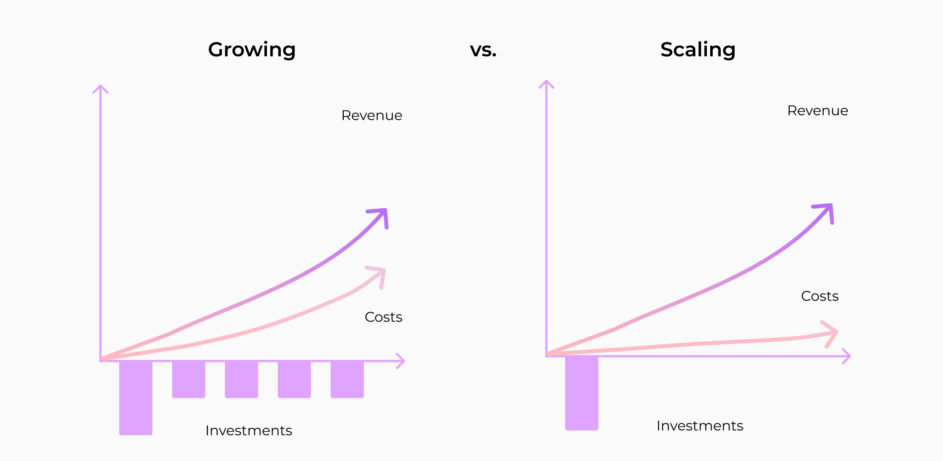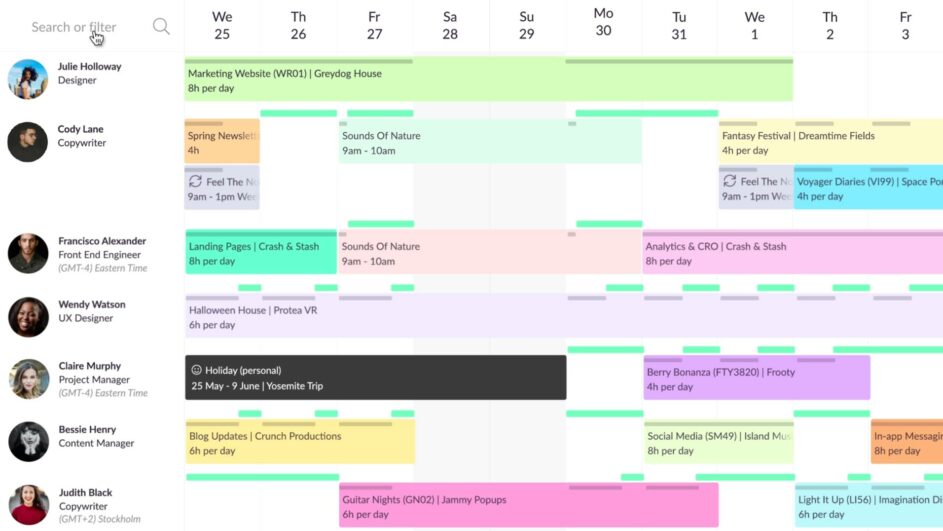Agency growth is about managing lots of moving parts—and managing them well. But then there’s the big question: revenue. How do you bring in more clients to keep growing sustainably?
This guide is designed to walk you through the key elements that go into growing an agency—from laying out your agency growth strategy to making it work in the real world.
We’ve also interviewed Michael Keenan, Co-founder of content marketing agency Peak, to get a better understanding of what it takes to grow an agency.
In this article 📖
What is agency growth?
Agency growth is the process of expanding your agency’s operations and capabilities by growing its client base, enhancing its service offerings, and strengthening its team to meet demand.
Think of it as evolving from a seedling into a full-blown tree. Agency growth is about having more branches, serving more clients, and increasing your overall impact in your industry.
Agency growth vs. agency scaling

While “growth” and “scaling” often get used interchangeably, they have different meanings, especially in the business world.
Agency growth is about expanding in size and volume. When you’re growing, you’re gaining more clients, hiring more staff, and possibly taking on more projects. But remember, as you grow, your costs might also increase. For instance, more clients might mean adding more headcount, which in turn leads to higher operational costs.
Now, imagine growing without significantly increasing your costs and keeping operations efficient. That’s scaling.
Agency scaling is about serving a larger number of clients or handling more projects without necessarily doubling or tripling your expenses.
Why is it important to grow an agency?
Establishing an agency is just the beginning. So, why exactly is growth so crucial?
Boost authority and customer trust: A bigger agency often translates to success in the industry. It’s like a stamp of approval that signifies your agency’s ability to deliver and meet client expectations consistently. Of course, in reality, we know that a bigger agency doesn’t always mean better.
Diversify your income: Growth allows you to diversify your offerings and tap into varied markets. Rather than focusing on one client type, you can spread your reach, catering to multiple client needs. Diversification is especially helpful during economic downturns when agencies are hit the hardest.
Retain your best employees: When your agency grows, so do the opportunities for your team. Career advancement, learning and development, and challenging your employees to grow all play a crucial role in cost-effective employee retention.
Seizing opportunities: Especially during recessions, many competitors might scale back their operations, providing growth-focused, nimble agencies with a chance to tap into new markets, acquire top talent, and increase revenue.
Better cash flow: Growth directly impacts profits. A bigger agency means more clients, more projects, and more revenue, which ultimately means more run rate. This is especially a plus when you’re planning for future investments for the business (think buying hardware or additional software seats).
Growth, whether during boom times or bust, is essential for agencies. It’s the lifeline that ensures sustainability, resilience, and long-term success.
What are some of the challenges of growing an agency?
Like every ambition, growing an agency comes with its unique set of challenges. Consider a few:
Resource management: As the workload increases, so does the challenge of efficiently managing agency resources. Striking a balance between billable and non-billable hours, ensuring optimal usage of your team’s skills, tracking dependencies, keeping up with timelines, and managing burnout are only some of the few key pillars of effectively managing resources.
Maintaining quality: While expanding, you need to maintain, if not improve, the quality of work. Growth should never come at the cost of compromised deliverables. With this challenge in mind, it’s important to know how much time your team is spending on managing vs. creating.
Operational roadblocks: Be it communication, project scope management, or client handling, operational challenges only get bigger with growth. This is where process improvements and using automation for more tedious management tasks become a critical part of growing an agency.
Financial pressures: Growth can sometimes put a strain on finances. Investments in infrastructure, technology, or talent may lead to temporary cash flow challenges—which is where best practices like resource forecasting for budgeting are critical.
How to grow an agency: 10 things to consider for your business
The best way to grow an agency is going to look different for every single one. That said, here are some things to think about when building your agency growth strategy.
1. Define what “growth” means for your agency
This is where you need to start. Classically, in the context of business, growth refers to the increase in an agency’s size, revenue, market share, and profitability over time.
By defining what “growth” means for your agency, you’ll be able to narrow down your focus and grow more effectively.
Once you’ve identified what type of growth you want, it’s time to look at your own data as well as the market.
2. Analyze your current market position and gather relevant data
To map out a growth journey, you first need to know your starting point. Think of this as understanding your agency’s place in the market’s grand jigsaw puzzle. One of the best ways to do this is through a SWOT analysis.

SWOT analysis table.
What’s a SWOT analysis? Imagine a square with four sections. Then, fill in the following:
- Strengths: In the top-left section, list out what your agency does best. Maybe you have a stellar design team, or perhaps clients love your unique approach to content marketing. This is about recognizing what sets you apart from the crowd.
- Weaknesses: On the top-right, be honest about areas that could use some improvement. Every agency has them. It might be a service you’re not quite nailing, or maybe there’s a persistent challenge in client communication. Recognizing these areas is the first step to addressing them.
- Opportunities: Bottom-left is for spotting those golden chances in the market. Maybe there’s a rising trend in the industry that you can capitalize on, or perhaps there’s a segment of potential clients that remains untapped.
- Threats: Finally, on the bottom right, consider external factors that could pose challenges. Are there new competitors on the horizon? Are there market shifts, like new regulations, that might affect how you operate?
Once you’ve filled out these sections, you’ll have a panoramic view of your agency’s current position. It’ll show you where you’re shining, where you need to improve, and what the market landscape looks like. With this knowledge, it’s easier to strategize and find ways to turn challenges into opportunities.
Data-driven decisions are pivotal. Don’t forget to collect data on market trends, competitors, and your own past performance. Tools like Google Analytics, industry reports, and client feedback can be instrumental in this step.
3. Set clear objectives
Specify measurable objectives like “increase revenue by 20% in the next year” or “expand client base by 50% in the next 18 months.” The more specific the better.
Consider a few more pointers during the setting objectives phase:
- Quantify objectives: Vague goals are unhelpful. Aim for S.M.A.R.T goals – Specific, Measurable, Achievable, Relevant, and Time-bound. This ensures your targets are both ambitious and rooted in reality.
- Diversify your goals: While financial targets are crucial, consider other aspects of growth too. For example, increasing client retention rates, improving team efficiency, or even enhancing brand perception can be just as valuable in the long term.
- Apply regular audits: The market, competition, and internal dynamics can change. It’s crucial to periodically review your objectives, at least quarterly, to ensure they’re still aligned with the agency’s broader vision and the industry’s landscape. If necessary, pivot.
- Engage your team: Growth isn’t just a top-down strategy. Engage your project owners in the goal-setting process. Their front-line insights can provide valuable input into what’s achievable and where opportunities lie. Plus, when the team is involved in setting goals, they’re more invested in achieving them.
4. Expand offerings and services
As an agency focused on growth, you don’t want to offer a buffet of just “adequate” services. Instead, focus on offering services in the few areas where you can really develop an edge and stand out.
This is where all your market analysis and research gets to shine. At this stage, you should have an idea of what current market demands are and what gaps in the market are leaving your ideal clients with unmet needs.
For example, if you notice that there’s a rising interest in, say, podcasting or video content, it could be a sign to integrate these services into your portfolio. Emerging markets are another area of opportunity, since there may not be a provider in those areas.
Once you’ve selected and defined what services you’ll provide to which target audience, double down and become the go-to expert for those needs. Be wary of diversifying too much.
5. Optimize and widen operations
At the heart of every thriving agency lies a robust and efficient operational framework. Before you think about expanding, it’s crucial to ask: “Is my agency running like a well-oiled machine?”
Today, agencies need to optimize for automation, speed, and client personalization.
Learn more about agency operations
6. Review your agency tech stack
Your agency tech stack can turn your agency into a growth machine—or completely throw a spanner into your growth engine. That’s why it’s important to review your tech stack, identify inefficiencies, and make sure it’s actually enabling your teams.
Discover how to build the best tech stack (and supercharge your teams)
7. Introduce resource management solutions

Schedule view in Resource Guru.
The bigger the agency, the more complex the resource management process. Investing in agency resource management software that’s both easy-to-use and flexible, ensures that you’re getting the most out of your team without overstretching them.
It makes it easier to balance billable hours, oversee project timelines, and speedy drag-and-drop scheduling features. It also helps you manage client projects end-to-end.
Take a look at the best resource management tools for agencies
8. Create an agency growth SOP toolkit
Standard Operating Procedures (SOPs) aren’t just corporate jargon. They’re blueprints that simplify operations, ensuring that every process aligns with your growth objectives. Plus, it’s a time saver and helps keep your team from trying to manage everything manually with disparate spreadsheets.
An SOP for growth can be a lifesaver, especially when your agency is growing.
Dive deeper into crafting impactful SOPs for agencies
9. Apply agile methodologies
While Agile methodology has its roots in software development, its principles can be adapted to agency work to make processes more flexible and responsive. Using sprint workflows, regular reviews, and adaptive planning leads to better project outcomes and more satisfied clients.
Learn more about Agile project management methodologies for agencies
10. Foster a culture of work-life balance
Who would have thought better work-life balance at agencies would work wonders for growth? Well, turns out it does. A finding by Gallup reveals that highly engaged employees result in 21% increased profitability.
Long story short? Happy and healthy employees are good for business.
Read all about establishing a better work-life balance at your agency
Growth examples for different types of agencies
Digital marketing agency growth
Define your niches: When it comes to marketing agencies it can get very competitive—fast. One way you can see rapid client growth is by focusing on a specific niche and then building out experience, expertise, and case studies.
Establishing your brand within a niche can really help you stand out and attract new clients seeking specialized services. Then, when you’ve become the industry leader for one niche, you can move on to the next, and continue growing.
SEO agency growth
Sign up your team for training, courses, and conferences: The only thing certain in SEO is change. From Google’s algorithms updates and fluctuating SERPs to increasing competition and AI—you want your team to stay on top of everything to remain competitive.
By staying on top of the latest trends, offering new SEO techniques to your clients, and experimenting with SEO strategies, you’ll stand out from competitors and be able to grow your SEO agency faster.
PPC agency growth
Invest in advanced tools: Tools really do make a difference in the quality of your PPC campaigns, so investing in the right tools can help you set up more successful PPC campaigns for your clients. Whether you’re looking to optimize bids. Improve your reporting, automate campaigns, or find competitor ad insights—there’s a tool for that.
Of course, happier clients can lead to higher campaign budgets or retainers, expanding into additional paid advertising channels, and even client referrals—all helping you grow your PPC agency.
Creative agency growth
Build an impressive portfolio (or update your existing one): When it comes to the creative world, being able to showcase your best work in a visually appealing portfolio or reel is key.
Highlight diverse projects that demonstrate your creativity and expertise in various media and styles, and then share this with prospective clients to grow your books.
Advertising agency growth
Build out strategic partnerships: When it comes to executing the most successful ad campaigns, you may need expertise or input outside of your immediate agency team (especially if you’re in the early stages of growth). Don’t let that put you off accepting new projects or clients.
Building out strategic partnerships can help you to add on relevant services needed to execute an advertising project—anything from consumer research specialists, to design studios or videographers.
This will help you say “yes” to more work, grow your agency, and eventually hire more specialist roles for your team without needing to outsource.
Agency growth secrets: Expert tips from Peak
To get an insider’s perspective, we spoke to Michael Keenan, co-founder of Peak, a boutique content marketing agency. Their journey began in 2021 with a straightforward mission: leverage strengths for immediate cash flow.
Michael’s initial vision was rooted in creating “high-value search-friendly content and designing an SEO strategy for blogs.” This strategy acted as a foundational stone for his agency’s marketing growth plan.
Michael, anticipating an impending recession and consequent layoffs, recognized that brands might hesitate to lean on freelancers during such uncertain times. This thinking is what propelled Peak’s new chapter. It was about identifying a fresh market segment that would benefit from their services.
As Michael explained, “The focus now is to help in-house teams at enterprise brands. They usually have a big content queue they need to fulfill, and they don’t have the resources internally to do it, so they hire us.”
The growth journey didn’t come without its challenges. For Peak, the most significant challenge was setting processes. From client onboarding to managing workflows, having a robust system in place was non-negotiable. A crucial element? Introducing “a workflow with a QA layer that had a fresh pair of eyes looking at final drafts.” This attention to detail was vital in ensuring sustainable growth.
“One challenge is finding good contractors at a fair price without overcharging your clients so you maintain a 20-25% profit margin.” Additionally, he emphasized taking the time and “playing with the numbers” to ensure that client demands were met without compromising on the quality or overstretching resources.
But for Michael, growth wasn’t just about numbers. It was about people. He shared, “I like to work with smart people and keep the team small.” This personalized approach to team dynamics is perhaps what sets Peak apart. It’s not about expanding at breakneck speeds but ensuring “incremental growth,” keeping the team happy, and always delivering top-notch content.
Peak’s recent success in landing one of the biggest contracts this year stands as a testament to an agency growth strategy done well.
Unlock your agency growth strategy
Executing a successful agency growth strategy isn’t just about expanding; it’s about evolving intelligently, and pivoting when something isn’t working.
As you navigate through your agency growth journey, be sure to use tools that integrate with your workflows seamlessly. Solutions like Resource Guru ensure that you’re spending your resources optimally—a key part of sustaining long-term growth.





